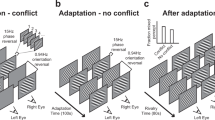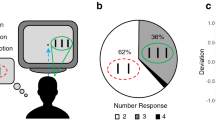Abstract
WHEN a simple target is viewed as a currently occurring retinal image which is confined to a specific locus, the target has been reported to lose contrast and to disappear1–3. The restriction of an image to a specific retinal locus is commonly termed a “stabilized retinal image”. This is the reverse situation to that encountered in normal vision where eye movements change the position of the retinal image several times a second. For more complex targets such as geometrical figures viewed as stabilized retinal images, intermittent disappearance and reappearance of the figure in whole or in part have been reported4–7. This striking phenomenon, usually outside the subject's previous visual experience, has been termed “fragmentation”. The common methods of investigating fragmentation are voluntary steady fixation, viewing as a partially stabilized retinal image using a contact lens and as a prolonged after-image (a completely stabilized retinal event)4–7. These methods in order progressively impose restraint on the image with respect to its retinal locus. Another method of investigating fragmentation was described by Evans8 and McFarland9. who note reports of fragmentation by subjects viewing geometrical figures for brief time intervals. Typically, the stimulus is viewed tachistoscopically near the recognition threshold after which the subject records his observations. This sequence is then repeated for many trials. We wish to describe another method of producing and studying fragmentation, by viewing a geometrical figure under intermittent illumination.
This is a preview of subscription content, access via your institution
Access options
Subscribe to this journal
Receive 51 print issues and online access
$199.00 per year
only $3.90 per issue
Buy this article
- Purchase on Springer Link
- Instant access to full article PDF
Prices may be subject to local taxes which are calculated during checkout
Similar content being viewed by others
References
Ditchburn, R. W., and Ginsborg, B. L., Nature, 170, 36 (1952).
Riggs, L. A., Ratliff, F., Cornsweet, J. C., and Cornsweet, T. N., J. Opt. Soc. Amer., 43, 495 (1953).
Yarbus, A. L., Biophysics, 2, 683 (1957).
Tscherning, M., Physiologic Optics, 285 (Keystone Press, 1904).
Pritchard, R. M., Heron, W., and Hebb, D. O., Canad. J. Psychol., 14 67 (1960).
Evans, C. R., and Piggins, D. J., Brit. J. Physiol. Opt., 20, 1 (1963).
Bennet-Clarke, H. C., and Evans, C. R., Nature, 199, 1215 (1963).
Evans, C. R., Brit. J. Psychol., 58, 315 (1967).
McFarland, J. H., Brit. J. Psychol., 56, 439 (1965).
Honisett, J., and Oldfleld, R. C., Scand. J. Psychol., 2, 49 (1961).
Evans, C. R., Brit. J. Psychol., 56, 121 (1965).
MacKinnon, G. E., Forde, J. J., and Piggins, D. J., Canad. J. Psychol., 23, 184 (1969).
Author information
Authors and Affiliations
Rights and permissions
About this article
Cite this article
PIGGINS, D. Fragmentation of a Geometrical Figure viewed under Intermittent Illumination. Nature 227, 730–731 (1970). https://doi.org/10.1038/227730a0
Received:
Issue Date:
DOI: https://doi.org/10.1038/227730a0
Comments
By submitting a comment you agree to abide by our Terms and Community Guidelines. If you find something abusive or that does not comply with our terms or guidelines please flag it as inappropriate.



